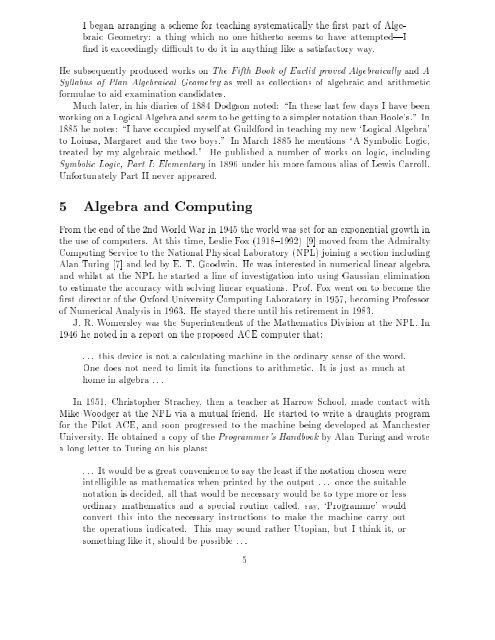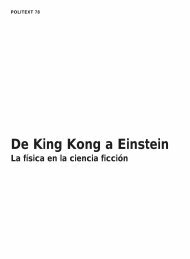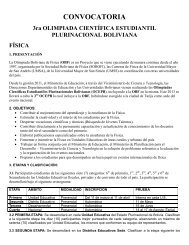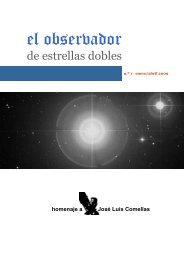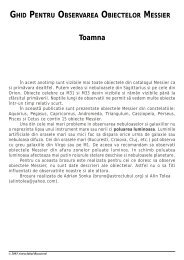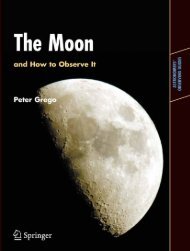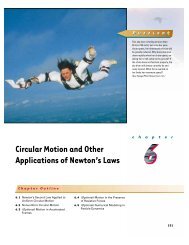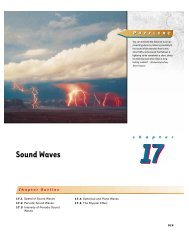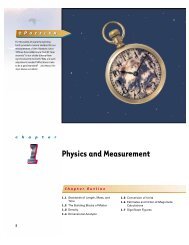A Brief History of Algebra and Computing: An Eclectic Oxonian View
A Brief History of Algebra and Computing: An Eclectic Oxonian View
A Brief History of Algebra and Computing: An Eclectic Oxonian View
You also want an ePaper? Increase the reach of your titles
YUMPU automatically turns print PDFs into web optimized ePapers that Google loves.
I began arranging a scheme for teaching systematically the rst part <strong>of</strong> <strong>Algebra</strong>ic<br />
Geometry: a thing which no one hitherto seems to have attempted|I<br />
nd it exceedingly di cult to do it in anything like a satisfactory way.<br />
He subsequently produced works on The Fifth Book <strong>of</strong> Euclid proved <strong>Algebra</strong>ically <strong>and</strong> A<br />
Syllabus <strong>of</strong> Plan <strong>Algebra</strong>ical Geometry as well as collections <strong>of</strong> algebraic <strong>and</strong> arithmetic<br />
formulae to aid examination c<strong>and</strong>idates.<br />
Much later, in his diaries <strong>of</strong> 1884 Dodgson noted: \In these last few days I have been<br />
working on a Logical <strong>Algebra</strong> <strong>and</strong> seem to be getting to a simpler notation than Boole's." In<br />
1885 he notes: \I have occupied myself at Guildford in teaching my new `Logical <strong>Algebra</strong>'<br />
to Loiusa, Margaret <strong>and</strong> the two boys." In March 1885hementions \A Symbolic Logic,<br />
treated by my algebraic method." He published a number <strong>of</strong> works on logic, including<br />
Symbolic Logic, Part I: Elementary in 1896 under his more famous alias <strong>of</strong> Lewis Carroll.<br />
Unfortunately Part II never appeared.<br />
5 <strong>Algebra</strong> <strong>and</strong> <strong>Computing</strong><br />
From the end <strong>of</strong> the 2nd World War in 1945 the world was set for an exponential growth in<br />
the use <strong>of</strong> computers. At this time, Leslie Fox (1918{1992) [9] moved from the Admiralty<br />
<strong>Computing</strong> Service to the National Physical Laboratory (NPL) joining a section including<br />
Alan Turing [7] <strong>and</strong> led by E. T. Goodwin. He was interested in numerical linear algebra<br />
<strong>and</strong> whilst at the NPL he started a line <strong>of</strong> investigation into using Gaussian elimination<br />
to estimate the accuracy with solving linear equations. Pr<strong>of</strong>. Fox went on to become the<br />
rst director <strong>of</strong> the Oxford University <strong>Computing</strong> Laboratory in 1957, becoming Pr<strong>of</strong>essor<br />
<strong>of</strong> Numerical <strong>An</strong>alysis in 1963. He stayed there until his retirement in 1983.<br />
J. R. Womersley was the Superintendent <strong>of</strong> the Mathematics Division at the NPL. In<br />
1946 he noted in a report on the proposed ACE computer that:<br />
. . . this device is not a calculating machine in the ordinary sense <strong>of</strong> the word.<br />
One does not need to limit its functions to arithmetic. It is just as much at<br />
home in algebra . . .<br />
In 1951, Christopher Strachey, thenateacher at Harrow School, made contact with<br />
Mike Woodger at the NPL via a mutual friend. He started to write a draughts program<br />
for the Pilot ACE, <strong>and</strong> soon progressed to the machine being developed at Manchester<br />
University. He obtained a copy <strong>of</strong>theProgrammer's H<strong>and</strong>book by AlanTuring <strong>and</strong> wrote<br />
a long letter to Turing on his plans:<br />
... Itwould be a great convenience to say the least if the notation chosen were<br />
intelligible as mathematics when printed by the output . . . once the suitable<br />
notation is decided, all that would be necessary would be to type more or less<br />
ordinary mathematics <strong>and</strong> a special routine called, say, `Programme' would<br />
convert this into the necessary instructions to make the machine carry out<br />
the operations indicated. This may sound rather Utopian, but I think it, or<br />
something like it, should be possible . . .<br />
5


